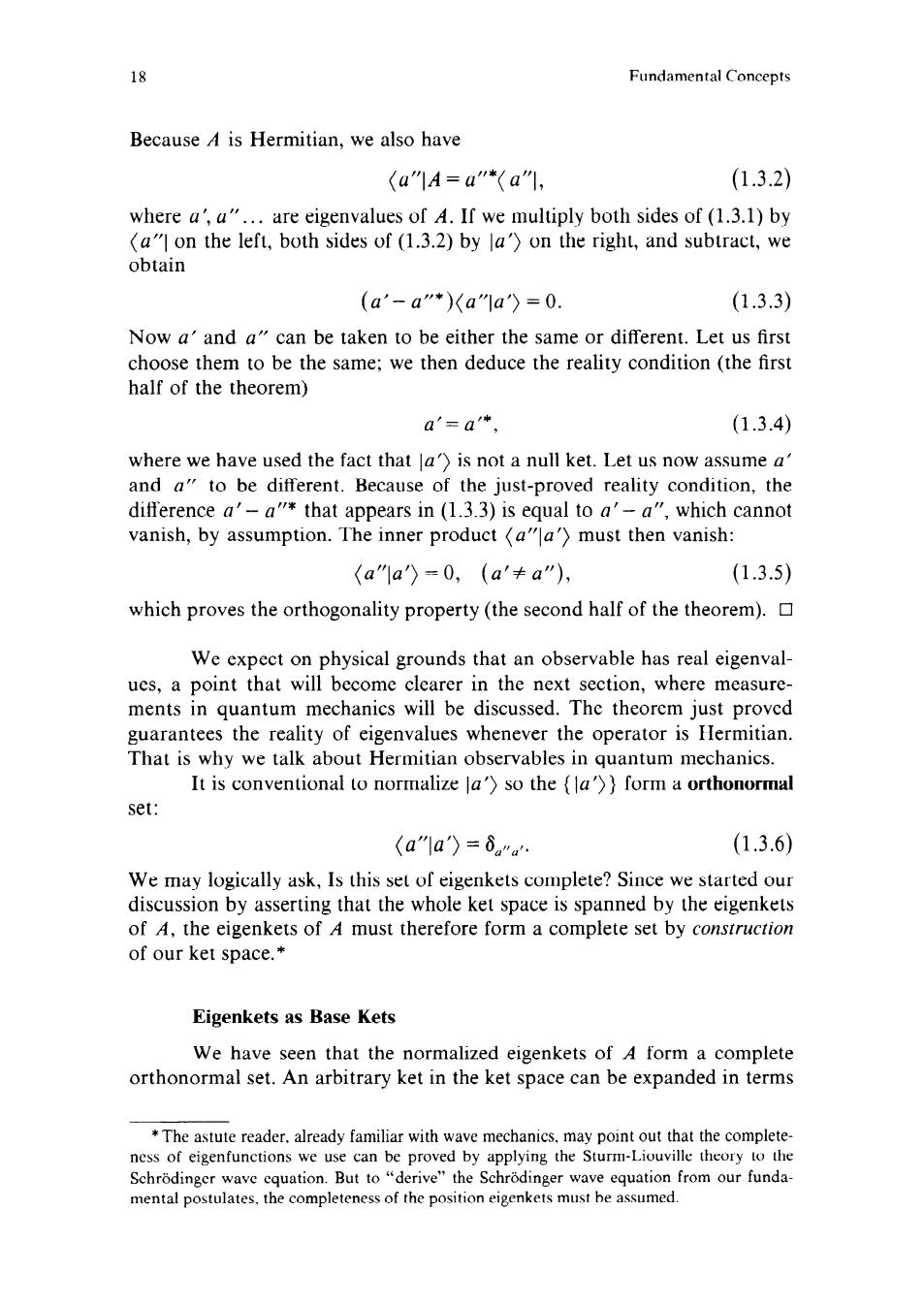
中 Fundamental Concepts Because A is Hermitian,we also have (a"A=a"*(a"1 (1.3.2) where a',a" are eigenvaluesof If we multiply both sides of(13.1)by (a"l on the left,both sides of (1.3.2)by la')on the right,and subtract,we obtain (a'-a"*)Ka"1a〉=0. (1.3.3) Now a'and a"can be taken to be either the same or different.Let us first choose them to be the same:we then deduce the reality condition (the first half of the theorem) a'=a*, 1.3.4 where we have used the fact that la)is not a null ket.Let us now assume a and a"to be different.Because of the just-proved reality condition,the difference a'-a"*that appears in (1.3.3)is equal to a'-a",which cannot vanish,by assumption.The inner product (a"la)must then vanish: (a'"1a)=0,(a'≠a"), (1.3.5) which proves the orthogonality property(the second half of the theorem). et on physical grounds that an observable has real eigenval- ues,a point that will become clearer in the next section,where measure. ments in quantum mechanics will be discussed.The theorem just proved guarantees the reality of eigenvalues whenever the operator is Hermitian. That is why we talk about Hermitian observables in antum mechanics It is conventional to normalize la'>so the (la>)form a orthonormal set: (a"1a)=δ"a (1.3.6) omplete?Since we started our of A.the eigenkets of A must therefore form a complete set by construction of our ket space.* Eigenkets as Base Kets We have seen that the normalized eigenkets of A form a complete orthonormal set.An arbitrary ket in the ket space can be expanded in terms Schroding r wave equation from our funda-
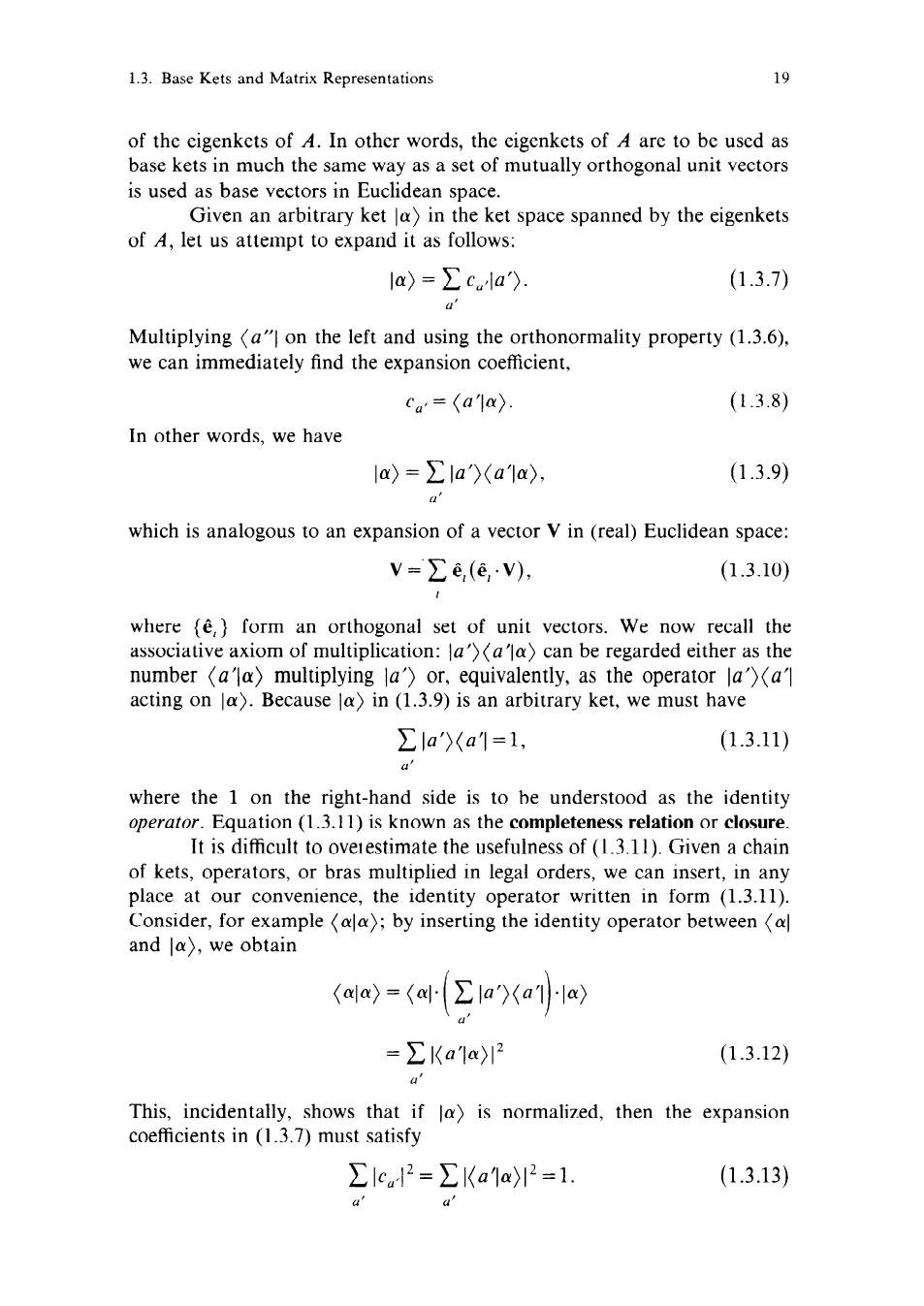
1.3.Base Kets and Matrix Representations 多 of the cigenkets of A.In other words,the eigenkets of A are to be used as base kets in much the same way as a set of mutually orthogonal unit vectors is used as base vectors in Euclidean space. Given an arbitrary ket )in the ket space spanned by the eigenkets of A,let us attempt to expand it as follows: la〉=∑cla) (1.3.7) Multiplying ("on the left and using the orthonormality property (1.3.6). we can immediately find the expansion coefficient, ca=(a1a (1.3.8) In other words,we have la)=∑la(a'1a). (1.3.9) which is analogous to an expansion of a vector V in (real)Euclidean space: V=∑e,(e,v), (1.3.10) where (e,)form an orthogonal set of unit vectors.We now recall the associative axiom of multiplication:laala)can be regarded either as the number (a'la)multiplying la')or,equivalently,as the operator la'(al acting on )Because la)in (1.3.9)is an arbitrary ket,we must have ∑la'a1=1, (1.3.11) where the 1 on the right-hand side is to be understood as the identity operator.Equation(1.3.11)is known as the completeness relation or closure It is difficult tooverestimate the usefulness of(13.11).Given a chair of kets,operators,or bras multiplied in legal orders,we can insert,in any place at our convenience,the identity operator written in form (1.3.11). Consider,for example ()by inserting the identity operator between and la),we obtain (a)=(a∑la)a7la) =∑Ka1aI2 (1.3.12) This,incidentally,shows that if la)is normalized,then the expansion coefficients in (1.3.7)must satisfy ∑lca2=∑Ka1a)12=1. (1.3.13)
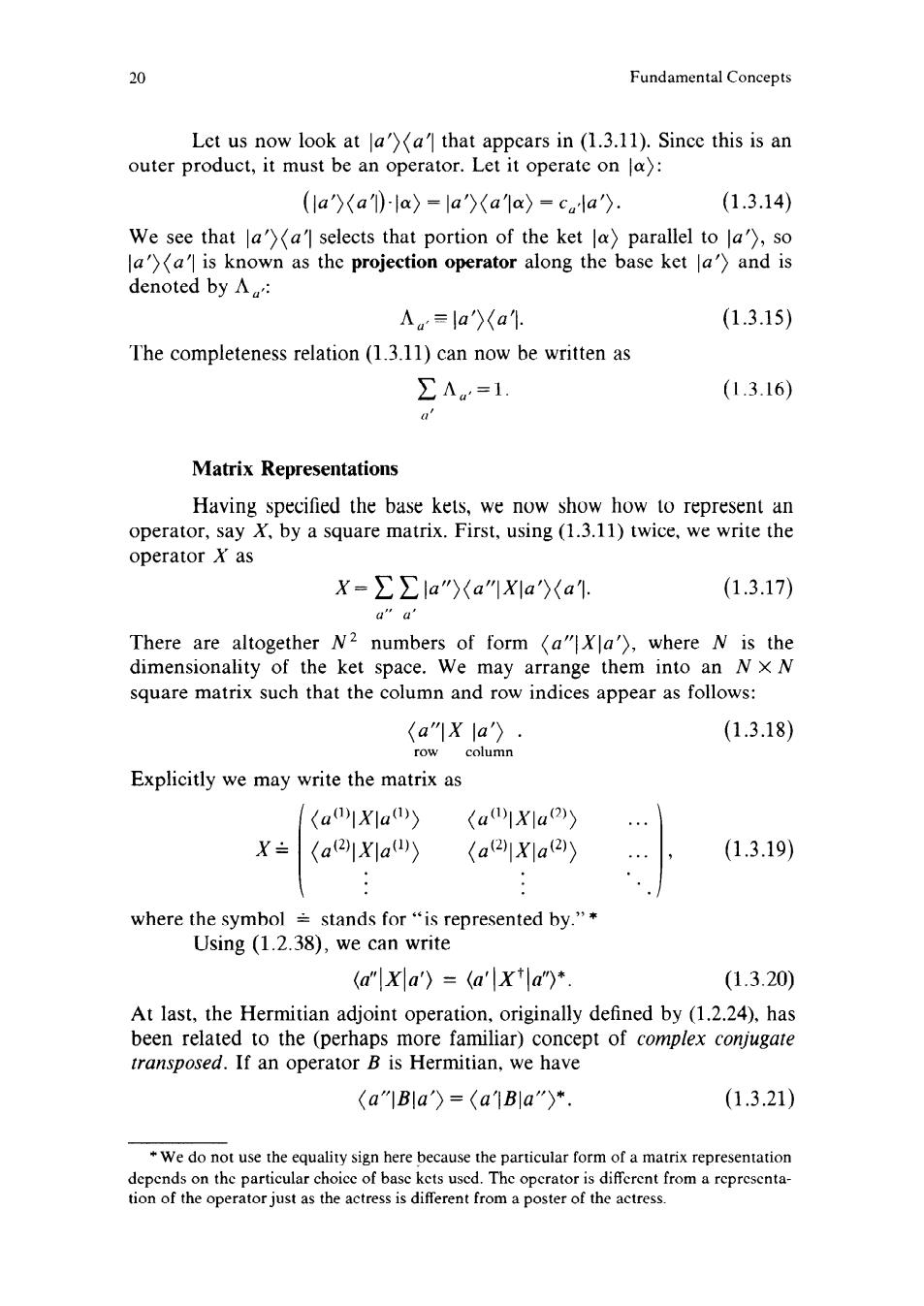
Fundamental Concepts Let us now look at la'a']that appears in (1.3.11).Since this is an outer product,it must be an operator.Let it operate on la): (la<a)-la)=la'(aa)=cla). (1.3.14) We see that a'selects that portion of the ket la)parallel to la'),so known as the projection operator along the base ket and is denoted by A: A=la(a (1.3.15) The completeness relation(1.3.11)can now be written as ∑A。=1. (1.3.16) Matrix Representations Having specified the base kets,we now show how to represent an operator,say X,by a square matrix.First,using (1.3.11)twice,we write the operator X as X-∑∑la"a"1X1a)a1. (1.317) a"d There are altogether N2 numbers of form (a"a),where N is the dimensionality of the ket space.We may arrange them into an NX N square matrix such that the column and row indices appear as follows: 〈a"1Xla〉. (1.3.18) columr Explicitly we may write the matrix as 〈a01Xa 〈a1X1a2) X÷ (a21X1a〉 (a(2)X a(2) (1.3.19) where the symbol stands for"is represented by."* Using (1.2.38),we can write (a"X a')=(a'X a")* (1.3.20) At last,the Hermitian adjoint operation originally defined by (1.2.24).has been related to the (perhaps more familiar)concept of complex conjugare transposed.If an operator B is Hermitian,we have (a"1B1a)=(a1B1a"* (1.3.21) "We do not use the sign here because the n of a matr the ofrsheactress is different from a poster of the actress nta repres
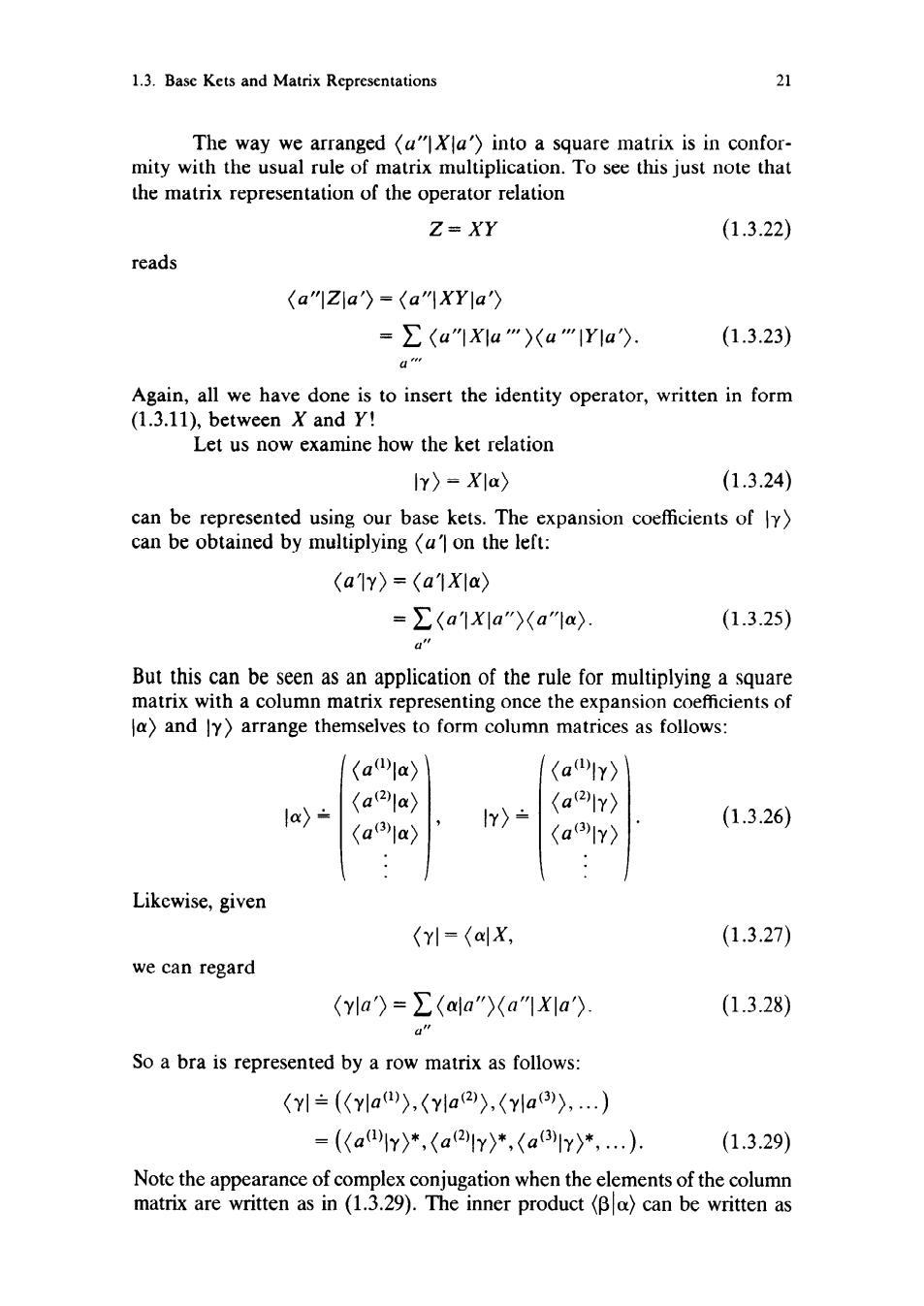
1.3.Base Kets and Matrix Representations 21 The way we arranged (a"Xla')into a square matrix is in confor- mity with the usual rule of matrix multiplication.To see this just note that the matrix representation of the operator relation Z=XY (1.3.22) reads 〈a"1Z1a=〈a"XYa =∑(a"1Xa")a"iYa) (1.3.23) Again,all we have done is to insert the identity operator,written in form (1.3.11),between X and Y! Let us now examine how the ket relation 1Y〉-X1a) (1.3.24) can be represented using our base kets.The expansion coefficients of ly) can be obtained by multiplying (a]on the left: (a1Y)=(a1X1a) =∑a1XIa")(a"1a〉 (1.3.25) But this can be seen as an application of the rule for multiplying a square matrix with a column matrix senting once the expansio and ly)arrange themselves to form column matrices as follows: (ada) la〉÷ (aa) (a3a〉 IY〉÷ (a2Y) (1.3.26) aY> Likewise,given <YI-<aIX (13.27) we can regard (yla)=∑(aa"a"1Xa'〉. (1.3.28) So a bra is represented by a row matrix as follows: (y=(yla四),ya2),(yla),…)) =(aY〉*,(a2ly〉*,(ay>*,…). (1.3.29) Note the appearance of complex x conjugation when the elements of the column matrix are written as in (1.3.29).The inner product (Ba)can be written as
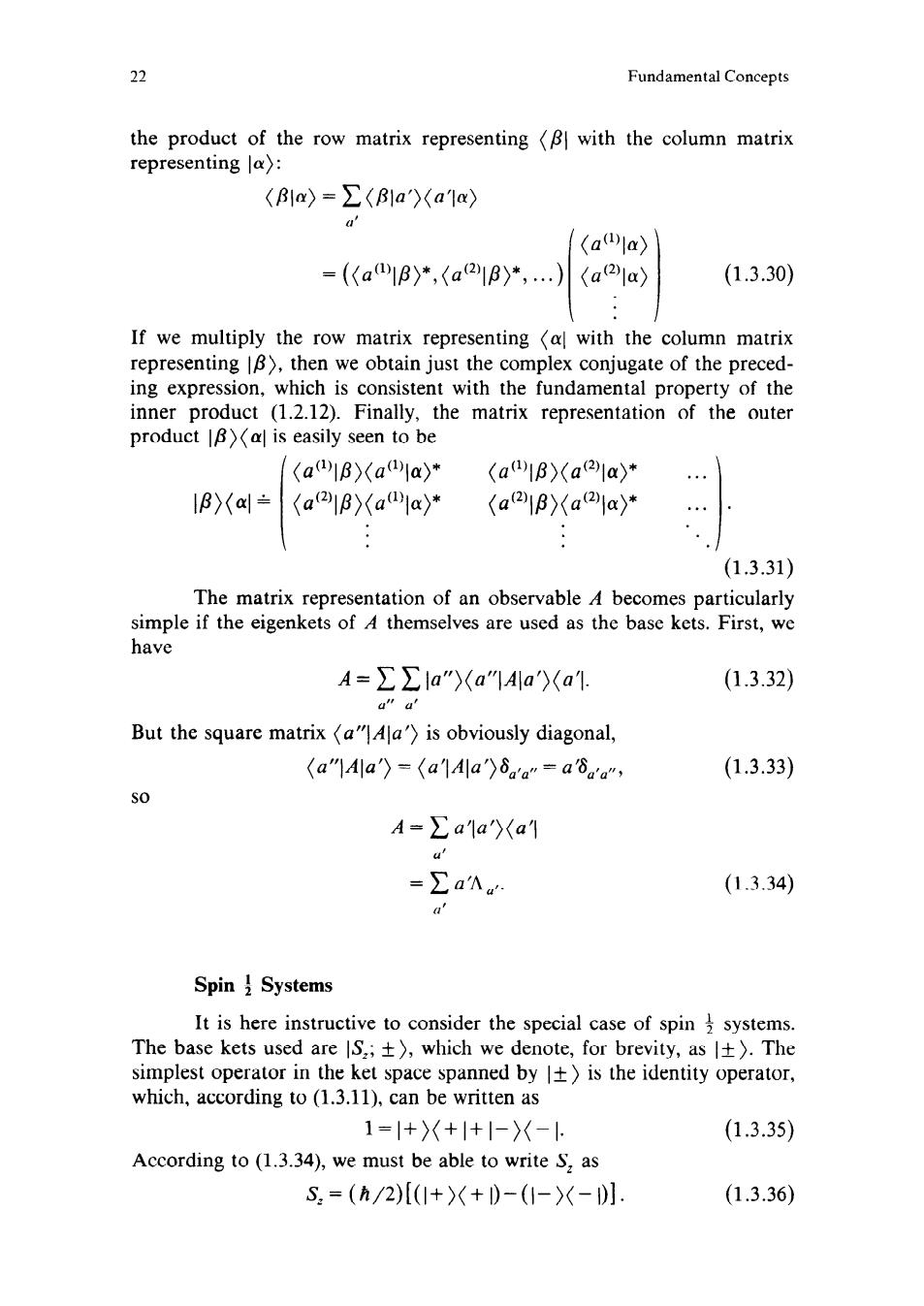
22 Fundamental Concepts the product of the row matrix representing (B with the column matrix representing la) (B)=∑(Ba')(a1a) a' (a1a) =(a1B)*,(a2lB>*,…)a2la〉 (1.3.30) If we multiply the row matrix representing with the colun mn matrix representing B),then we obtain just the complex conjugate of the preced- ing expression,which is consistent with the fundamental property of the inner product (1.2.12).Finally,the matrix representation of the outer product 1B)(is easily seen to be (a()B)(aa)* KaB>(a2a)* … IB)<al= a2B)ala)* (aB)(a2a)* (1.3.31) The matrix representation of an observable A becomes particularly simple if the eigenkets of themselves are used as the base kets.First,we have A=∑∑la")a"IAa)(a1. (1.3.32) But the square matrix (a"Ala')is obviously diagonal, (a"JAla)=(a Ala)8a'a"=a'8aa" (1.3.33) A=∑a1aa1 u" =Ea'n (1.3.34) a' Spin Systems It is here instructive to consider the special case of spin systems The base kets used are S;士),which we enote,,for brevity,.asl±〉.The simplest operator in the ket space spanned byis the identity operator, which,according to (1.3.11),can be written as 1=|+)X+1+|-)X- (1.3.35) According to (1.3.34),we must be able to write S:as S.=(n/2)[(I+)+)-(I-)X-川. (1.3.36)